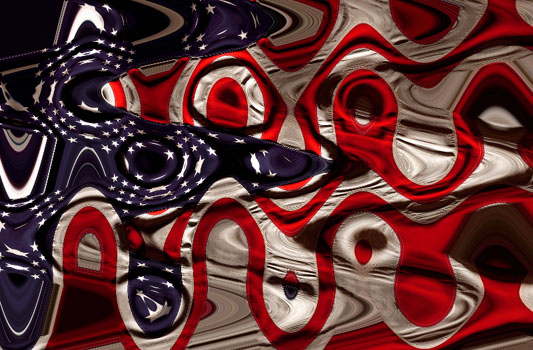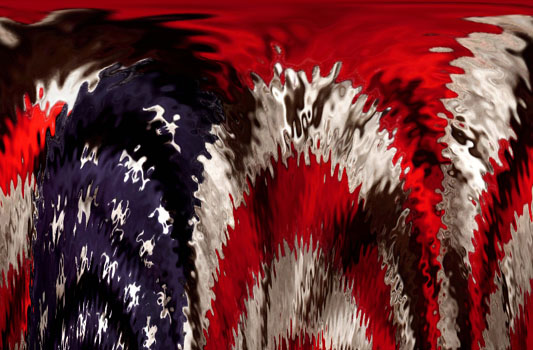

American Flag Sine 25
Art by Norman E. Masters
Imagine this scene: all the school children in a class stand at attention in military formation, click their heels together, thrust their right arms stiffly upward and forward, and recite a loyalty oath to the government. Any child who refuses to recite this oath is expelled from school or even jailed. If images of Nazi Germany came to mind, it is no coincidence. (More on that later.) School scenes like this were real, and started taking place in the 1890s -- in the United States.
It all began in 1892 when Francis Bellamy or James Bailey Upham wrote a loyalty oath as part of America's first Columbus Day celebration. Both men worked at a magazine called "Youth's Companion." Upham, was in charge of coordinating a national celebration of the 400th anniversary celebration of the landing of Columbus. The celebration focused on government schools and a flag ceremony with a loyalty pledge. The families of both Bellamy and Upham each claim their ancestor was the true author of the pledge, and there is evidence for both.
At the time, there was already a fairly well known flag oath, written by a Colonel Balch in 1889. He wrote it for students at his free kindergarten for the children of the poor and immigrants in New York. Every day, his students would stand and recite, "We give our heads and our hearts to God and our country; one country, one language, one Flag." During the recitation, the youngsters would point at their heads, their heart and then at the flag. This pledge ending with the students' arms stretched toward the flag may have inspired the later stiff-armed salute.
According to one version, Upham wrote many drafts of a pledge, but never found one he and the magazine liked. At some point, he asked Bellamy to write it. Bellamy came up with, "I pledge allegiance to my Flag and the Republic for which it stands; one Nation, indivisible, with Liberty and Justice for all."
Bellamy was a radical socialist who believed all schools and other public institutions should be nationalized and militarized because a "military-socialist complex" would be much more "efficient." He was also a racist who believed segregation in public schools should be mandatory. Francis Bellamy's cousin, Edward Bellamy, shared Francis's views, and was a well-known writer. Edward wrote an internationally popular novel, "Looking Backwards" (translated into 20 foreign languages) about the ideal totalitarian military-socialist society.
It is said that when Bellamy showed his version of the pledge to Upham, in August, 1892, it had no physical salute, but Upham was inspired. He came to attention, snapped his heels together and chanted, "I pledge allegiance to my flag," and he stretched out his right arm and hand with palm up while he recited the rest of the pledge. The original instructions for the pledge read,
"At a signal from the Principal the pupils, in ordered ranks, hands to the side, face the Flag. Another signal is given; every pupil gives the Flag the military salute -- right hand lifted, palm downward, to a line with the forehead and close to it. Standing thus, all repeat together, slowly: 'I pledge allegiance to my Flag and the Republic for which it stands; one Nation, indivisible, with Liberty and Justice for all.' At the words, 'to my Flag,' the right hand is extended gracefully, palm upward, towards the Flag, and remains in this gesture till the end of the affirmation; whereupon all hands immediately drop to the side."
The daily ritual of a loyalty oath caught on in America because around this time the country saw a huge influx of immigrants. Many established Americans feared that these immigrants would remain more loyal to their previous home countries than to the United States. If the children of these newcomers were required to recite a loyalty oath everyday, it might indoctrinate and condition these foreigners -- or as Bellamy put it, "Americanize" them. He believed this would lead children to embrace nationalism, militarism, and socialism.
Over the past century, a myth has developed that this loyalty oath was created to sell flags to schools and Francis Bellamy is described as an advertising pioneer. The story joined other patriotic fabrications such as George Washington chopping down a cherry tree, and story that Betsy Ross sewed the first American flag.
The first change to the oath came in 1923. It occurred to some that saying "my flag" could mean anyone's favorite flag, so it was changed to "the flag of the United States" so that no one could privately pledge to a foreign flag. The next year, "of America" was added.
Washington was the first state to legally require every school child to recite the oath. This was mandated shortly after WWI -- February 1919, the same month as the Seattle general strike, which had spread fears of a communist takeover. Other states followed suit in 1920, and legal challenges soon followed. In 1925, a 9-year-old Bellingham, Washington boy was expelled from public school for following his religious objection to reciting a loyalty oath. A judge ordered that the boy be taken from his parents and put into a state home where he was held for more than two years. His parents were not allowed to even visit him, and the state began the process of putting him up for adoption. In November 1927 a different judge restored him to his parents, who sent him to a private school.
By the 1930s, the stiff-armed salute to the American flag was firmly established and well known. Whether the National Socialist German Workers' Party (Nazi Party) copied the flag salute or got the idea from similar fictitious salutes that appeared in early American movies is debated by historians. In any case, the similarity was so striking and so embarrassingly reminded everyone of the original reason for the loyalty pledge that the Nazi-like salute was replaced with placing the hand over the heart in 1942.
Twice the question of whether the state could force a child to recite the pledge went to the U.S. Supreme Court. The first case, in 1940, came when Hitler was pushing across France. Preempting the court's decision, President Roosevelt declared a national emergency and decreed that the pledge could be mandated by law. The second case came in 1943, when the Allies were winning. The court -- not wanting America to subjugate its citizens in the manner of the totalitarian governments it was fighting -- reversed itself. Today, no American can legally be forced to say the Pledge of Allegiance or any other loyalty oath.
The addition of "under God" came in 1954 to distinguish America from atheistic communists. (In 1955 the phrase "In God We Trust" was added to U.S. currency.)
Recently, the U.S. Ninth Circuit Court of Appeals ruled the Pledge of Allegiance was unconstitutional and said it should not be recited in schools with the phrase "under God" in it. Some liberals agree with the ruling because is supports the separation of church and state. Some conservatives oppose the Pledge of Allegiance in general because forcing anyone to recite an oath to freedom strikes them as an insult to the American commitment to universal, individual rights, and promotes subjugation of the individual to the state.
For more on the history of the Pledge of Allegiance, see To the Flag : The Unlikely History Of The Pledge Of Allegiance by Richard J. Ellis, The Pledge of Allegiance & the Bellamys by Rex Curry, & The Pledge of Allegiance -- A Short History by Dr. John W. Baer

American Flag Ripple Polar 2
Art by Norman E. Masters
 |
 |
 |